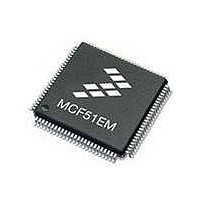MCF51EM256CLL Freescale Semiconductor, MCF51EM256CLL Datasheet - Page 536

MCF51EM256CLL
Manufacturer Part Number
MCF51EM256CLL
Description
IC MCU 32BIT 256KB FLASH 100LQFP
Manufacturer
Freescale Semiconductor
Series
MCF51EMr
Datasheets
1.MCF51EM128CLL.pdf
(2 pages)
2.MCF51EM128CLL.pdf
(54 pages)
3.MCF51EM128CLL.pdf
(636 pages)
Specifications of MCF51EM256CLL
Core Processor
Coldfire V1
Core Size
32-Bit
Speed
50MHz
Connectivity
I²C, SCI, SPI
Peripherals
LCD, LVD, PWM, WDT
Number Of I /o
63
Program Memory Size
256KB (256K x 8)
Program Memory Type
FLASH
Ram Size
16K x 8
Voltage - Supply (vcc/vdd)
1.8 V ~ 3.6 V
Data Converters
A/D 16x12b
Oscillator Type
External
Operating Temperature
-40°C ~ 85°C
Package / Case
100-LQFP
Processor Series
MCF51EM
Core
ColdFire V1
Data Bus Width
32 bit
Data Ram Size
16 KB
Interface Type
RS-232, LIN
Maximum Clock Frequency
50 MHz
Number Of Timers
3
Operating Supply Voltage
1.8 V to 3.6 V
Maximum Operating Temperature
+ 85 C
Mounting Style
SMD/SMT
3rd Party Development Tools
JLINK-CF-BDM26, EWCF
Development Tools By Supplier
DEMOEM
Minimum Operating Temperature
- 40 C
Lead Free Status / RoHS Status
Lead free / RoHS Compliant
Eeprom Size
-
Lead Free Status / Rohs Status
Lead free / RoHS Compliant
Available stocks
Company
Part Number
Manufacturer
Quantity
Price
Company:
Part Number:
MCF51EM256CLL
Manufacturer:
FREESCALE
Quantity:
110
Company:
Part Number:
MCF51EM256CLL
Manufacturer:
Freescale Semiconductor
Quantity:
10 000
- Current page: 536 of 636
- Download datasheet (11Mb)
LCD Driver Module
SOURCE
BRATE[2:0]
LCLK[2:0]
÷(2
12+BRATE[2:0]
Blink Frequency
)
Alternate Clock
LCDCLK
÷4
÷ 2 x (4+LCLK[2:0]) x Y)
OSCOUT = 32.768 kHz
÷6∗(2
LADJ[1:0]
)
LCD Base Clock
÷ (DUTY+1)
Blink Rate
LCD Charge Pump Clock
Source
LADJ[1:0]
LCD Frame Frequency
Figure 24-11. LCD Clock Tree
An external 32.768 kHz clock input is required to achieve lowest power consumption.
The value of LCDCLK is important because it is used to generate the LCD module frame frequency.
Equation 24-1
provides an expression for the LCD module frame frequency calculation.
The LCD module frame frequency is a function of the LCD module duty cycle as shown in
Equation
24-1.
Table 24-16
and
Table 24-15
show LCD module frame frequency calculations that consider several
possible LCD module configurations of LCLK[2:0] and DUTY[2:0].
The LCD module frame frequency is defined as the number of times the LCD segments are energized per
second. The LCD module frame frequency must be selected to prevent the LCD display from flickering
(LCD module frame frequency is too low) or ghosting (LCD module frame frequency is too high). To
avoid these issues, an LCD module frame frequency in the range of 28 to 58 Hz is required. LCD module
frame frequencies less than 28 Hz or greater than 58 Hz are out of specification, and so are invalid.
Selecting lower values for the LCD base and frame frequency results in lower current consumption for the
LCD module.
The LCD module base clock frequency is the LCD module frame frequency multiplied by the number of
backplane phases that are being generated. The number of backplane phases is selected using the
DUTY[2:0] bits. The LCD module base clock is used by the backplane sequencer to generate the LCD
waveform data for the enabled phases (A-H).
MCF51EM256 Series ColdFire Integrated Microcontroller Reference Manual, Rev. 8
24-20
Freescale Semiconductor
Related parts for MCF51EM256CLL
Image
Part Number
Description
Manufacturer
Datasheet
Request
R

Part Number:
Description:
BOARD DEMO HARDWARE ONLY
Manufacturer:
Freescale Semiconductor
Datasheet:

Part Number:
Description:
IC MCU 32BIT 128KB FLASH 100LQFP
Manufacturer:
Freescale Semiconductor
Datasheet:

Part Number:
Description:
IC MCU 32BIT 128KB FLASH 80LQFP
Manufacturer:
Freescale Semiconductor
Datasheet:

Part Number:
Description:
IC MCU 32BIT 256KB FLASH 80LQFP
Manufacturer:
Freescale Semiconductor
Datasheet:
Part Number:
Description:
Manufacturer:
Freescale Semiconductor, Inc
Datasheet:
Part Number:
Description:
Manufacturer:
Freescale Semiconductor, Inc
Datasheet:
Part Number:
Description:
Manufacturer:
Freescale Semiconductor, Inc
Datasheet:
Part Number:
Description:
Manufacturer:
Freescale Semiconductor, Inc
Datasheet:
Part Number:
Description:
Manufacturer:
Freescale Semiconductor, Inc
Datasheet:
Part Number:
Description:
Manufacturer:
Freescale Semiconductor, Inc
Datasheet:
Part Number:
Description:
Manufacturer:
Freescale Semiconductor, Inc
Datasheet:
Part Number:
Description:
Manufacturer:
Freescale Semiconductor, Inc
Datasheet:
Part Number:
Description:
Manufacturer:
Freescale Semiconductor, Inc
Datasheet:
Part Number:
Description:
Manufacturer:
Freescale Semiconductor, Inc
Datasheet:











